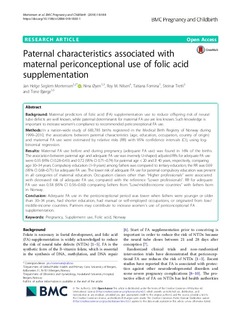| dc.contributor.author | Mortensen, Jan Helge Seglem | |
| dc.contributor.author | Øyen, Nina | |
| dc.contributor.author | Nilsen, Roy Miodini | |
| dc.contributor.author | Fomina, Tatiana | |
| dc.contributor.author | Tretli, Steinar | |
| dc.contributor.author | Bjørge, Tone | |
| dc.coverage.spatial | Norway | nb_NO |
| dc.date.accessioned | 2019-01-22T14:39:33Z | |
| dc.date.available | 2019-01-22T14:39:33Z | |
| dc.date.created | 2018-06-23T20:18:52Z | |
| dc.date.issued | 2018 | |
| dc.identifier.citation | Mortensen, J. H. S., Øyen, N., Nilsen, R. M., Fomina, T., Tretli, S., & Bjørge, T. (2018). Paternal characteristics associated with maternal periconceptional use of folic acid supplementation. BMC Pregnancy and Childbirth, 18(1), 1-8. | nb_NO |
| dc.identifier.issn | 1471-2393 | |
| dc.identifier.uri | http://hdl.handle.net/11250/2581838 | |
| dc.description.abstract | Background
Maternal predictors of folic acid (FA) supplementation use to reduce offspring risk of neural tube defects are well known, while paternal determinants for maternal FA use are less known. Such knowledge is important to increase women’s compliance to recommended periconceptional FA use.
Methods
In a nation-wide study of 683,785 births registered in the Medical Birth Registry of Norway during 1999–2010, the associations between paternal characteristics (age, education, occupation, country of origin) and maternal FA use were estimated by relative risks (RR) with 95% confidence intervals (CI), using log-binomial regression.
Results
Maternal FA use before and during pregnancy (adequate FA use) was found in 16% of the births. The association between paternal age and adequate FA use was inversely U-shaped; adjusted RRs for adequate FA use were 0.35 (95% CI 0.28–0.43) and 0.72 (95% CI 0.71–0.74) for paternal age < 20 and ≥ 40 years, respectively, comparing age 30–34 years. Compulsory education (1–9 years) among fathers was compared to tertiary education; the RR was 0.69 (95% CI 0.68–0.71) for adequate FA use. The lower risk of adequate FA use for paternal compulsory education was present in all categories of maternal education. Occupation classes other than “Higher professionals” were associated with decreased risk of adequate FA use, compared with the reference “Lower professionals”. RR for adequate FA use was 0.58 (95% CI 0.56–0.60) comparing fathers from “Low/middle-income countries” with fathers born in Norway.
Conclusion
Adequate FA use in the periconceptional period was lower when fathers were younger or older than 30–34 years, had shorter education, had manual or self-employed occupations, or originated from low/middle-income countries. Partners may contribute to increase women’s use of periconceptional FA supplementation. | nb_NO |
| dc.language.iso | eng | nb_NO |
| dc.publisher | BioMed Central | nb_NO |
| dc.rights | Navngivelse 4.0 Internasjonal | * |
| dc.rights.uri | http://creativecommons.org/licenses/by/4.0/deed.no | * |
| dc.subject | pregnancy | nb_NO |
| dc.subject | supplement use | nb_NO |
| dc.subject | folic acid | nb_NO |
| dc.title | Paternal characteristics associated with maternal periconceptional use of folic acid supplementation | nb_NO |
| dc.type | Journal article | nb_NO |
| dc.type | Peer reviewed | nb_NO |
| dc.description.version | publishedVersion | nb_NO |
| dc.rights.holder | © The Author(s). | nb_NO |
| dc.subject.nsi | VDP::Medisinske Fag: 700::Helsefag: 800::Forebyggende medisin: 804 | nb_NO |
| dc.source.pagenumber | 1-8 | nb_NO |
| dc.source.volume | 18 | nb_NO |
| dc.source.journal | BMC Pregnancy and Childbirth | nb_NO |
| dc.identifier.doi | 10.1186/s12884-018-1830-1 | |
| dc.identifier.cristin | 1593437 | |
| cristin.unitcode | 203,3,50,0 | |
| cristin.unitname | Institutt for sykepleiefag - Bergen | |
| cristin.ispublished | true | |
| cristin.fulltext | original | |
| cristin.qualitycode | 1 | |

